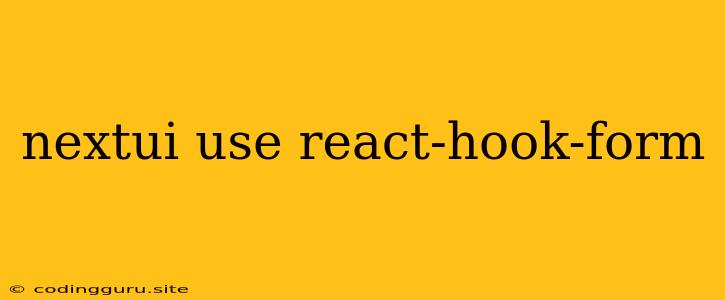Harnessing the Power of NextUI with React Hook Form: A Comprehensive Guide
Building a user-friendly and performant web application requires choosing the right tools. When it comes to forms in React, two popular choices stand out: NextUI and React Hook Form. Combining these two libraries empowers you to craft efficient, visually appealing forms that enhance the user experience. This guide explores the synergy between NextUI and React Hook Form, providing insights and practical examples to help you maximize their potential.
Why Choose NextUI and React Hook Form?
NextUI is a modern and versatile UI library for building beautiful and responsive user interfaces with React. Its pre-built components, including forms, provide a solid foundation for rapid development. React Hook Form excels at managing form state and validation, simplifying the process of handling user input and ensuring data integrity.
Let's delve into the benefits of using NextUI and React Hook Form together:
The Power of NextUI's Form Components
NextUI offers a collection of form components that streamline the development process:
- Input: Provides various input types like text, email, password, and more, allowing you to capture user information effectively.
- Textarea: Enables users to input longer blocks of text, ideal for comments or feedback.
- Checkbox: Offers a simple way to allow users to make binary selections.
- Radio: Enables users to select a single option from a list of choices.
- Select: Allows users to choose a single or multiple values from a dropdown list.
These components are styled to match the aesthetic of NextUI, ensuring a consistent and polished look for your forms.
Enhancing Form Functionality with React Hook Form
React Hook Form provides a powerful and intuitive way to manage form state and validation without the need for complex state management solutions:
- Controlled Inputs: Easily connect your NextUI form components to React Hook Form's state, allowing you to track and update input values in real-time.
- Validation: Define rules for input validation to ensure data quality and prevent errors. You can implement custom validation logic or utilize built-in validators.
- Error Handling: Access validation errors and display them elegantly to users, providing clear feedback and guidance.
Putting It All Together: A Practical Example
Let's consider a simple contact form example:
import { useState } from "react";
import { useForm } from "react-hook-form";
import { Input, Button, Text } from "nextui-org";
function ContactForm() {
const [successMessage, setSuccessMessage] = useState("");
const { register, handleSubmit, formState: { errors } } = useForm();
const onSubmit = (data) => {
// Implement your form submission logic here
// For example, you can send the data to a server
console.log(data);
setSuccessMessage("Your message has been sent successfully!");
};
return (
);
}
export default ContactForm;
In this example, we use NextUI's Input, Textarea, and Button components for a visually appealing form. React Hook Form's useForm hook provides the necessary functions to manage form state, validation, and error handling. The register method connects the input fields to the form state, and the handleSubmit method triggers the onSubmit function when the form is submitted. Validation rules are defined using the required and pattern options within register. Errors are displayed using the errors object provided by React Hook Form.
Key Considerations
- Form Optimization: When working with complex forms, consider using React Hook Form's advanced features such as
useWatchto monitor specific input values,setValueto update form state directly, andgetValuesto retrieve form data easily. - Accessibility: Ensure your forms are accessible to all users by following best practices for ARIA attributes, keyboard navigation, and screen reader compatibility.
- Performance: React Hook Form is known for its efficiency, but in large forms, consider optimizing the validation logic and using techniques like lazy initialization to improve performance.
Conclusion
Combining NextUI and React Hook Form empowers you to create user-friendly, stylish, and functional forms in your React applications. By leveraging the strengths of both libraries, you can streamline development, enhance user experience, and build forms that meet the specific needs of your project.
